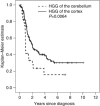Cerebellar location may predict an unfavourable prognosis in paediatric high-grade glioma
- PMID: 23868007
- PMCID: PMC3749574
- DOI: 10.1038/bjc.2013.404
Cerebellar location may predict an unfavourable prognosis in paediatric high-grade glioma
Abstract
Background: High-grade glioma (HGG) of the cerebellum accounts for only 5% of paediatric HGG. Since little is known about these tumours, the present study aimed at their further characterisation.
Methods: Twenty-nine paediatric patients with centrally reviewed cerebellar HGG were identified from the HIT-GBM/HIT-HGG database. Clinical and epidemiological data were compared with those of 180 paediatric patients with cortical HGG.
Results: Patients with cerebellar tumours were younger (median age of 7.6 vs 11.7 years, P=0.028), but both groups did not differ significantly with regard to gender, tumour predisposing syndromes, secondary HGG, primary metastasis, tumour grading, extent of tumour resection, chemotherapy regimen, or radiotherapy. Except for an increased incidence of anaplastic pilocytic astrocytoma (APA) in the cerebellar subset (20.7% vs 3.3%; P<0.001), histological entities were similarly distributed in both groups. As expected, tumour grading had a prognostic relevance on survival. Compared with cortical HGG, overall survival in the cerebellar location was significantly worse (median overall survival: 0.92 ± 0.02 vs 2.03 ± 0.32 years; P=0.0064), and tumour location in the cerebellum had an independent poor prognostic significance as shown by Cox-regression analysis (P=0.019).
Conclusion: High-grade glioma represents a group of tumours with an obviously site-specific heterogeneity associated with a worse survival in cerebellar location.
Figures
References
-
- Benesch M, Wagner S, Berthold F, Wolff JE. Primary dissemination of high-grade gliomas in children: experiences from four studies of the Pediatric Oncology and Hematology Society of the German Language Group (GPOH) J Neurooncol. 2005;72 (2:179–183. - PubMed
-
- Bertolone SJ, Yates AJ, Boyett JM, Wallace D, Finlay JL. Combined modality therapy for poorly differentiated gliomas of the posterior fossa in children: a Children's Cancer Group report. J Neurooncol. 2003;63 (1:49–54. - PubMed
-
- Campbell JW, Pollack IF, Martinez AJ, Shultz B. High-grade astrocytomas in children: radiologically complete resection is associated with an excellent long-term prognosis. Neurosurgery. 1996;38 (2:258–264. - PubMed
-
- Chamberlain MC, Silver P, Levin VA. Poorly differentiated gliomas of the cerebellum. A study of 18 patients. Cancer. 1990;65 (2:337–340. - PubMed
-
- Djalilian HR, Hall WA. Malignant gliomas of the cerebellum: an analytic review. J Neurooncol. 1998;36 (3:247–257. - PubMed
Publication types
MeSH terms
LinkOut - more resources
Full Text Sources
Other Literature Sources
Research Materials



